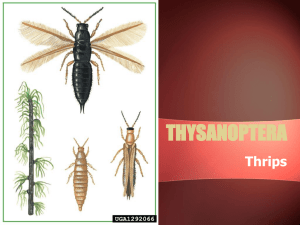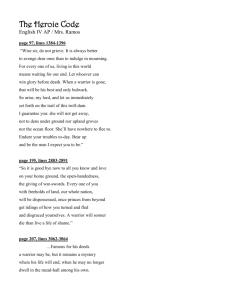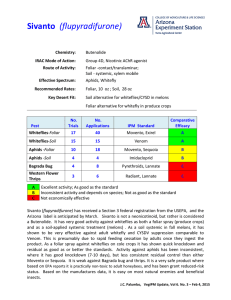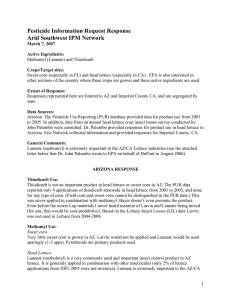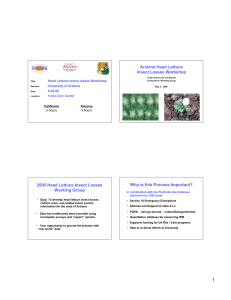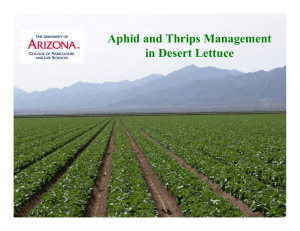Management of Western Flower Thrips in Head Lettuce Abstract
advertisement
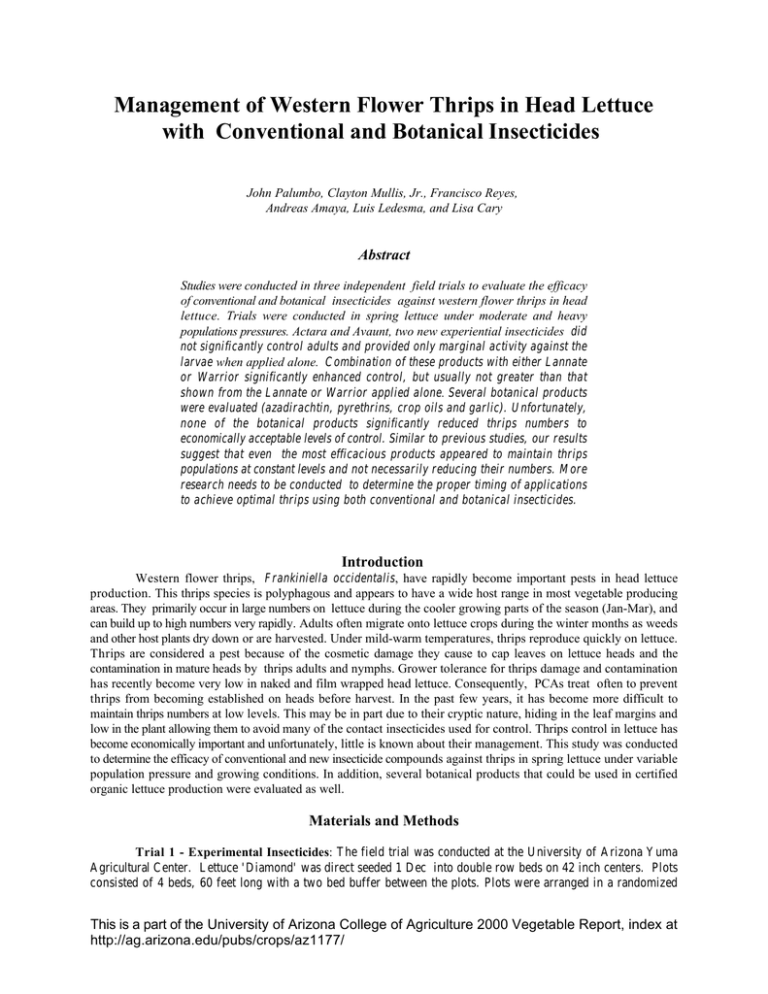
Management of Western Flower Thrips in Head Lettuce with Conventional and Botanical Insecticides John Palumbo, Clayton Mullis, Jr., Francisco Reyes, Andreas Amaya, Luis Ledesma, and Lisa Cary Abstract Studies were conducted in three independent field trials to evaluate the efficacy of conventional and botanical insecticides against western flower thrips in head lettuce. Trials were conducted in spring lettuce under moderate and heavy populations pressures. Actara and Avaunt, two new experiential insecticides did not significantly control adults and provided only marginal activity against the larvae when applied alone. Combination of these products with either Lannate or Warrior significantly enhanced control, but usually not greater than that shown from the Lannate or Warrior applied alone. Several botanical products were evaluated (azadirachtin, pyrethrins, crop oils and garlic). Unfortunately, none of the botanical products significantly reduced thrips numbers to economically acceptable levels of control. Similar to previous studies, our results suggest that even the most efficacious products appeared to maintain thrips populations at constant levels and not necessarily reducing their numbers. More research needs to be conducted to determine the proper timing of applications to achieve optimal thrips using both conventional and botanical insecticides. Introduction Western flower thrips, Frankiniella occidentalis, have rapidly become important pests in head lettuce production. This thrips species is polyphagous and appears to have a wide host range in most vegetable producing areas. They primarily occur in large numbers on lettuce during the cooler growing parts of the season (Jan-Mar), and can build up to high numbers very rapidly. Adults often migrate onto lettuce crops during the winter months as weeds and other host plants dry down or are harvested. Under mild-warm temperatures, thrips reproduce quickly on lettuce. Thrips are considered a pest because of the cosmetic damage they cause to cap leaves on lettuce heads and the contamination in mature heads by thrips adults and nymphs. Grower tolerance for thrips damage and contamination has recently become very low in naked and film wrapped head lettuce. Consequently, PCAs treat often to prevent thrips from becoming established on heads before harvest. In the past few years, it has become more difficult to maintain thrips numbers at low levels. This may be in part due to their cryptic nature, hiding in the leaf margins and low in the plant allowing them to avoid many of the contact insecticides used for control. Thrips control in lettuce has become economically important and unfortunately, little is known about their management. This study was conducted to determine the efficacy of conventional and new insecticide compounds against thrips in spring lettuce under variable population pressure and growing conditions. In addition, several botanical products that could be used in certified organic lettuce production were evaluated as well. Materials and Methods Trial 1 - Experimental Insecticides: The field trial was conducted at the University of Arizona Yuma Agricultural Center. Lettuce 'Diamond' was direct seeded 1 Dec into double row beds on 42 inch centers. Plots consisted of 4 beds, 60 feet long with a two bed buffer between the plots. Plots were arranged in a randomized This is a part of the University of Arizona College of Agriculture 2000 Vegetable Report, index at http://ag.arizona.edu/pubs/crops/az1177/ complete block design with four replications. Insecticide treatments and rates used in the trial are found in Table 1. The foliar spray treatments were applied in 25 GPA total volume at 40 psi. A spreader/sticker was used in all treatments (DyneAmic at 0.25% v/v). Three, disc-type cone nozzles were used per bed. Three applications were made on 3, 10, 15 March. Evaluation of thrips control was based on the number of live adults and nymphs per plant sampled from the center 2 rows of each replicate at intervals following each application. Samples were taken on 1, 6, 9, 15, 19, and 22 March. Numbers of thrips adults and larvae from 8 plants per replicate were recorded on each sample. Samples were taken by removing plants and beating them vigorously against a screened pan for a predetermined duration. Inside of the pan was a sticky trap to catch the dislodged thrips. Sticky traps were then taken to the laboratory where adult and larvae were counted. Percentage reduction of thrips compared with the untreated control was calculated following the formula given by Henderson & Tilton (1955). Trial 2 - Botanical Insecticides: The field trial was conducted at the University of Arizona Yuma Agricultural Center. Lettuce 'Diamond' was direct seeded 2 Dec into double row beds on 42 inch centers. Plots consisted of 4 beds, 60 feet long with a two bed buffer between the plots. Plots were arranged in a randomized complete block design with four replications. Insecticide treatments and rates used in the trial are found in Table 1. The foliar spray treatments were applied in 25 GPA total volume at 40 psi. A spreader/sticker was used only in the Conventional Rotation (DyneAmic at 8 oz/acre). Three, disc-type cone nozzles were used per bed. Three applications were made on 2, 9, 14 March. .Evaluation of thrips control was based on the number of live adults and nymphs per plant sampled from the center 2 rows of each replicate at intervals following each application. Samples were taken on 28 Feb, 6, 9, 14, 17, and 21 March. Numbers of thrips adults and larvae from 5-8 plants per replicate were recorded on each sample. Samples were taken by removing plants and beating them vigorously against a screened pan for a predetermined duration. Inside of the pan was a sticky trap to catch the dislodged thrips. Sticky traps were then taken to the laboratory where adult and larvae were counted. Percentage reduction of thrips compared with the untreated control was calculated following the formula given by Henderson & Tilton (1955). Table 1. Description of treatments and rates used in trials 1 and 2, YAC, Spring 2000. Trial 1 - Experimental Insecticides Trial 2 - Botanical Insecticides Treatment Rate (product/acre) Actara 25W 4.5 oz Treatment Rate (product/acre) Neemix + Comate 1 pt + 4 oz Actara +Warrior 3.0 oz +3.8 oz Ecozin +Comate 10 oz + 4 oz Actara +Lannate 3.0 oz + 0.8 lb Pyrellin + Comate 1.5 pt + 4 oz Enviropel + Tomahawk 32 oz + 12 oz Success 6.0 oz Success +Warrior 4.0 oz + 3.8 oz Neemix + Trilogy 1 pt + 32 oz Success +Lannate 4.0 oz + 0.8 lb Neemix + Enviropel + Tomahawk 1 pt + 32 oz + 12 oz Lannate SP 0.8 lb Neemix + Trilogy + Tomahawk+ Pyrellin 1 pt + 32 oz + 12 oz +1.5 pt Warrior T 3.8 oz Ecozin + Enviropel+Tomahawk 10 oz + 32 oz + 12 oz Avaunt 3.5 oz Pyrellin + Enviropel + Tomahawk 1.5 pt + 32 oz + 12 oz 8 oz Avaunt +Warrior 3.5 oz + 3.8 oz Comate Avaunt +Lannate 3.5 oz + 0.8 lb Lannate + Warrior 0.8 lb + 3.8 oz Conventional Rotation 1st ) Success 2nd ) Lannate + Warrior 3rd ) Success + Warrior Trial 3 - Late-season Lettuce. (0.25%) 6.0 oz 0.8 lb + 3.8 oz 4.0 oz + 3.8 oz Lettuce 'Beacon' was direct seeded 15 Jan into double row beds on 42 inch centers. Plots consisted of 4 beds, 60 feet long with a two bed buffer between the plots. Plots were arranged in a randomized complete block design with four replications. Insecticide treatments and rates used in the trial are found in the table below. The foliar spray treatments were applied in 33 GPA total volume at 40 psi. A spreader/sticker was used only in the first four treatments (DyneAmic at 8 oz/acre), none was used in treatment 5); and comate at 0.125% v/v was used in the remaining treatments. Three, disc-type cone nozzles were used per bed. Three applications were made on 23 March, and 1 and 6 April. Evaluation of thrips control was based on the number of live adults and nymphs per plant sampled from the center 2 rows of each replicate at intervals following each application. Samples were taken on23, 27 and 30 March, and 4 and 12 April. Numbers of thrips adults and larvae from 5-8 plants per replicate were recorded on each sample. Samples were taken by removing plants and beating them vigorously against a screened pan for a predetermined duration. Inside of the pan was a sticky trap to catch the dislodged thrips. Sticky traps were then taken to the laboratory where adult and larvae were counted. Percentage reduction of thrips compared with the untreated control was calculated following the formula given by Henderson & Tilton (1955). Treatment Rate (product/acre) 1. Actara 25W 4.5 oz 2. Success 6.0 oz 3. Lannate + Warrior 0.8 lb + 3.8 oz 4. Provado Rotation Provado+ Lannate Provado+Thiodan Provado+Mustang 3.75 oz + 0.8 lb 3.75 oz + 32 oz 3.75 oz+ 4.2 oz 5. Diatect / Sulfur 6 lbs + 3 pts 6. Mpede 2.6 qts 7. Hot Pepper Wax 2 gal Results and Discussion Trial 1 - Experimental Insecticides: Thrips species in all of theses this studies were predominantly western flower thrips, Frankiniella occidentalis. Both adult and nymph populations were moderate-high at the beginning of the study ( <20 adults/ plant and >80 larvae / plant; plants were in the early heading stage). In previous trials , Avaunt showed some activity against thrips, and Actara has been shown to have activity on other thrips species. However, when applied as individual compounds in head lettuce, they did not significantly control WFT adults and provided only marginal activity against the larvae (Tables 2-4). Combination of either Lannate and Warrior with these compounds significantly enhanced control, but usually not significantly greater than either the Lannate or Warrior applied alone (Figure 1). In contrast, the combinations of reduced rates of Success ( 4.0 oz) with Lannate or Warrior provided similar control as Success applied alone at a higher rates. Consequently, all three Success treatments controlled thrips similarly to the Lannate+Warrior combination. Trial 2 - Botanical Insecticides: Because of the recent interest in certified organic lettuce production we evaluated several botanical formulations of azadirachtin (Neemix and Ecozin), pyrethrin (pyrellin), Garlic (Enviropel), and crop oil concentrates (Trilogy, Comate) which supposedly have activity against WFT. Adult and larval populations were moderate to high (>100 total thrips; plants were in the early heading stage ). Unfortunately none of the products provided much residual activity against either thrips adults or larvae (Table 5). Of the botanicals insectcides evaluated, the Comate and Neemix+Comate, provided the most consistent activity. However, neither treatment provided greater than 25% reduction of total thrips (Figure 2). This may have been a result of marginal insecticide efficacy of these botanical compounds, or because control became more difficult as the season progressed due to migration and increased plant size. This latter point is illustrated by the marginal control found in the conventional rotation (Table 5). Trial 3. Late Season Lettuce. This trial was conducted on late- planted lettuce that was allowed to harbor large numbers of thrips prior to spraying. The number of thrips were high at the initiation of the test (>110 /plant; plants were in the early heading stage) and almost tripled in the check by the completion of the test. Only the Lannate+Warrior and Success treatments provided significant adult activity, but did not prevent the population from increasing to very high numbers (Table 1). Actara and the Provado rotations appeared to reduce larval and total thrips numbers when compared with the untreated check (Table 2). Unfortunately, Lannate/Warrior and Success were the only treatments to actually prevent larval population from increasing. Although these materials appeared to control nymphs better than adults, our data may not reflect the rapid development of nymphs or the immigration of adults from surrounding fields during the study. Unfortunately, the botanical products significantly reduce thrips numbers when compared with the untreated check (Figure 3). We had hopes that the Diatect (diatomaceous earth and pyrethrins) and sulfur (flowable) would have activity as aqueous sprays. We speculate whether these products would be more active applied as dusts. Conclusions. Of the new products tested, only Success had activity as a stand alone product. Although Actara and Avaunt combinations were efficacious, their cost-effectiveness is questionable when considering the availability of other compounds (ie Admire, Success). However, Actara combinations similar to what were used in these studies may have utility in head lettuce because of activity against aphids. Similarly, Avaunt combinations may be useful because of the compounds excellent activity against worms. Overall, thrips control in all of these studies was moderately acceptable at best. Part of this may be due to the fact that large numbers of WFT were allowed to become established in large, heading plants before the spray treatments were initiated. In addition, we have experienced in previous trials that plant size and temperature are important factors contributing to insecticide efficacy. The larger the plant, the more difficult it is to obtain good coverage underneath the leaf and near the base of the plant where larvae and adults inhabit. The 1999/2000 growing season in Yuma was unusually warm, and thrips built up to very large numbers due to the high temperatures driving their development. Consequently, even the most efficacious products appeared to maintain thrips populations at constant levels and not necessarily reducing their number. Thus, more research needs to be conducted to determine the proper timing and frequency of applications to achieve optimal thrips using both conventional and botanical insecticides. Acknowledgment Funding for this research was provided by the following sources: Arizona Iceberg Lettuce Research Council, Dow AgriSciences, DuPont Agricultural Products, Novartis Crop Protection , Zeneca and FMC. Table 2. Trial 1 - Adult Thrips Abundance on Head Lettuce Treated with Conventional and Experimental Insecticide Combinations, Yuma Agric. Center, Spring 2000. Mean No. Adults / Plant Treatment 6 March 9 March 15 March 19 March 22 March Average 14.8 ab 21.5 ab 27.2 ab 21.6 ab 24.0 a 21.8 ab Actara 3.0 oz + Warrior 3.8 oz 8.7 bc 16.0 bc 13.6 e 30.4 a 17.2 a 17.7 bc Actara 3.0 oz +Lannate 0.7 lb 5.1 c 9.9 c 14.3 de 7.6 bc 24.8 a 12.3 cd Avaunt 3.5 oz 15.9 ab 25.5 a 33.8 a 20.2 ab 24.1 a 23.9 a Avaunt 3.5 oz +Warrior 3.8 oz 8.3 bc 15.1 bc 11.8 e 3.6 c 9.2 a 9.6 d Avaunt3.5 oz +Lannate 0.7 lb 5.6 c 10.9 c 23.6 bcd 4.4 c 23.6 a 13.6 cd Success -6.0 oz 6.6 c 16.3 bc 23.7 bc 4.4 c 16.4 a 13.5 cd Success -4.0 oz +Warrior 3.8 oz 6.7 c 11.7 c 13.4 e 3.2 c 19.6 a 10.9 d Success -4.0 oz +Lannate 0.7 lb 3.5 c 15.4 bc 14.7 cde 8.0 bc 27.2 a 13.8 cd Lannate -0.9 lb 4.5 c 11.8 c 16.7 cde 11.2 bc 11.2 a 11.0 d Warriror 3.8 oz 5.3 c 12.4 c 9.5 e 8.0 bc 12.0 a 9.4 d Lannate 0.75 +Warrior 3.5 oz 3.7 c 10.5 c 9.7 e 7.6 bc 24.4 a 11.1 d Untreated 18.7 a 26.5 a 35.8 a 22.0 ab Precount samples taken on 1 March: 18.25 adults/plant; Applications made on March 3, 10, and 15 Means followed by the same letter are not significantly different ANOVA(LSD p>0.05) 22.4 a 25.0 a Actara 4.5 oz Table 3. Trial 1 - Thrips Larvae Abundance on Head Lettuce Treated with Conventional and Experimental Insecticide Combinations, Yuma Agric. Center, Spring 2000. Mean No. Larvae / Plant Treatment 6 March 9 March 15 March 19 March 22 March Average Actara 4.5 oz 31.9 ab 34.1 a 19.5 a 12.0 bc 23.2 b 24.1 b Actara 3.0 oz + Warrior 3.8 oz 23.0 bc 34.9 a 16.1 a 9.6 bcd 13.2 bc 19.4 cd Actara 3.0 oz +Lannate 0.7 lb 21.9 bc 23.2 bc 13.1 a 6.0 bcd 7.2 c 14.3 efg Avaunt 3.5 oz 33.0 ab 35.0 a 18.8 a 25.0 ab 34.7 ab 29.3 ab Avaunt 3.5 oz +Warrior 3.8 oz 32.2 ab 30.2 ab 15.8 a 6.8 bcd 15.2 bc 20.0 bcd Avaunt3.5 oz +Lannate 0.7 lb 23.3 bc 23.1 bc 16.0 a 8.4 bcd 14.8 bc 17.1 de Success -6.0 oz 14.9 c 19.4 c 11.5 a 5.6 bcd 9.2 bc 12.1 g Success -4.0 oz +Warrior 3.8 oz 21.5 bc 23.7 bc 17.5 a 5.6 bcd 13.2 bc 16.4 def Success -4.0 oz +Lannate 0.7 lb 14.4 c 21.5 bc 11.8 a 3.6 bcd 11.2 bc 12.5 fg Lannate -0.9 lb 14.3 c 21.5 bc 11.9 a 1.2 d 5.6 c 10.9 g Warriror 3.8 oz 32.8 ab 29.6 ab 18.7 a 12.4 b 15.2 bc 21.7 bc Lannate 0.75 +Warrior 3.5 oz 20.2 bc 24.2 bc 15.2 a 2.7 cd 9.2 bc 14.3 efg Untreated 42.3 a 27.8 abc 24.7 a 33.2 a Precount samples taken on 1 March: 80.8 larvae/plant; Applications made on March 3, 10, and 15 Means followed by the same letter are not significantly different ANOVA(LSD p>0.05) 46.4 a 34.8 a Table 4. Trial 1 - Total Thrips Abundance on Head Lettuce Treated with Conventional and Experimental Insecticide Combinations, Yuma Agric. Center, Spring 2000. Mean No. Total Thrips / Plant Treatment 6 March 9 March 15 March 19 March 22 March Average 46.7 ab 55.3 a 46.6 ab 33.6 bc 47.2 ab 45.9 b Actara 3.0 oz + Warrior 3.8 oz 31.7 bcde 50.9 ab 29.7 cd 40.0 ab 30.4 bc 36.5 c Actara 3.0 oz +Lannate 0.7 lb 27.1 cde 33.1 c 27.4 cd 13.6 d 32.0 bc 26.7 de Avaunt 3.5 oz 48.9 ab 60.5 a 52.6 ab 45.2 ab 58.8 ab 53.2 ab Avaunt 3.5 oz +Warrior 3.8 oz 40.5 bc 45.3 abc 27.6 cd 10.4 d 24.4 bc 29.6 cd Avaunt3.5 oz +Lannate 0.7 lb 28.9 bcde 34.1 c 39.7 bc 12.8 d 38.4 bc 30.8 cd Success -6.0 oz 21.5 de 36.7 c 35.2 bcd 10.0 d 25.6 bc 25.6 de Success -4.0 oz +Warrior 3.8 oz 28.2 cde 35.4 c 30.9 cd 8.8 d 32.8 bc 27.3 de Success -4.0 oz +Lannate 0.7 lb 17.9 e 36.9 c 26.5 cd 11.6 d 38.4 bc 26.3 de Lannate -0.9 lb 18.7 e 33.3 c 28.5 cd 12.4 d 16.8 c 22.0 e Warriror 3.8 oz 38.1 bcd 42.0 bc 28.2 cd 20.4 cd 27.2 bc 31.2 cd Lannate 0.75 +Warrior 3.5 oz 23.9 cde 34.7 c 24.9 d 10.2 d 33.6 bc 25.5 de Untreated 61.0 a 54.3 a 60.2 a 55.2 a Precount samples taken on 1 March: 99.0 total thrips/plant; Applications made on March 3, 10, and 15 Means followed by the same letter are not significantly different ANOVA(LSD p>0.05) 68.8 a 59.9 a Actara 4.5 oz Figure 1. % Reduction Compared with the Untreated Control 70 Thrips Control in Head Lettuce with New Insectcide Active Ingrediants, YAC, Spring 2000 Adults -Seasonal Average Control 60 50 40 30 20 10 0 Actara % Reduction Compared with the Untreated Control 80 Actara Warrior Actara Lannate Avaunt Avaunt Warrior Avaunt Success Success Success Lannate Warrior Lannate Warrior Lannate Lannate Warrior Larvae -Seasonal Average Control 70 60 50 40 30 20 10 0 Actara Actara Warrior Actara Lannate Avaunt Avaunt Warrior Avaunt Success Success Success Lannate Warrior Lannate Warrior Lannate Lannate Warrior Total Thrips - Seasonal Average Control % Reduction Compared with the Untreated Control 80 70 60 50 40 30 20 10 0 Actara Actara Warrior Actara Lannate Avaunt Avaunt Warrior Avaunt Success Success Success Lannate Warrior Lannate Warrior Lannate Lannate Warrior Table 5. Trial 2 - Thrips Abundance on Head Lettuce Treated with Botanical Insecticide Combinations, Yuma Agric. Center, Spring 2000. Mean No. Thrips / Plant March 6th (4 DAT1) Treatment March 9th (7 DAT 1) March 14th (5 DAT 2) Adult Larvae Total Adult Larvae Total Adult Larvae Total Neemix+Comate 26.2 cde 48.1 ab 74.3 abc 33.8 abc 44.1 a 77.9 a 17.6 a 22.8 a 40.4 a Ecozin+Comate 28.5 abcd 57.5 ab 85.9 ab 32.0 abc 38.7 a 70.7 a 36.4 a 34.0 a 70.4 a Pyrellin+Comate 33.9 a 47.1 ab 81.0 abc 36.7 abc 38.6 a 75.3 a 42.8 a 36.0 a 78.8 a Enviropel 25.6 de 49.9 ab 75.5 abc 35.2 abc 45.6 a 80.8 a 36.8 a 19.2 a 56.0 a Neemix+Trilogy 23.7 de 37.5 abc 61.2 bc 36.4 abc 54.0 a 90.4 a 33.6 a 30.8 a 64.4 a 26.5 bcde 45.3 ab 71.9 abc 28.0 c 47.6 a 75.6 a 31.2 a 20.4 a 51.6 a Neemix+Trilogy+Pyrellin+Enviropel 32.7 ab 60.0 a 92.3 a 42.4 ab 46.4 a 88.8 a 27.6 a 37.6 a 65.2 a Ecozin+Enviropel 25.1 de 46.7 ab 71.7 abc 29.2 bc 52.0 a 81.2 a 30.8 a 24.4 a 55.2 a Pyrellin+Enviropel 32.0 abc 47.2 ab 79.3 abc 42.8 a 51.0 a 94.4 a 47.6 a 34.0 a 81.6 a Comate 20.9 e 36.2 bc 57.1 cd 38.0 abc 44.4 a 82.4 a 21.2 a 22.0 a 43.2 a Conventional Rotation 10.6 f 22.2 c 32.8 d 10.4 d 16.8 b 27.2 b 25.6 a 14.4 a 40.0 a 26.4 cde 42.6 abc 70.0 abc 33.6 abc 41.6 a 75.2 a 52.8 a 36.0 a 88.8 a Neemix+Enviropel Untreated Precount samples: 20.5 adults/plant; 84.17 larvae / plant; 104.3 total thrips/plant Table 5. Trial 2 - cont. Mean No. Thrips / Plant March 17th (3 DAT3) March 21st (7 DAT 3) Seasonal Average Treatment Adult Larvae Total Adult Larvae Total Adult Larvae Total Neemix+Comate 22.4 a 32.0 ab 54.4 bc 5.2 a 9.6 a 14.8 a 21.0 cd 31.3 ab 52.4 d Ecozin+Comate 31.2 a 32.8 ab 64.0 abc 7.6 a 20.4 a 28.0 a 27.1 abc 36.7 a 63.8 abc Pyrellin+Comate 369.0 a 35.2 ab 71.2 ab 7.2 a 15.6 a 22.8 a 31.3 a 34.5 ab 65.8 abc Enviropel 33.2 a 44.4 a 77.6 a 8.4 a 18.0 a 26.4 a 27.8 abc 35.4 ab 63.3 abc Neemix+Trilogy 22.0 a 22.4 bc 44.4 cd 7.2 a 12.0 a 19.2 a 24.6 abc 31.3 ab 55.9 cd Neemix+Enviropel 31.2 a 32.8 ab 64.0 abc 12.8 a 13.2 a 26.0 a 25.9 abc 31.9 ab 57.8 bcd Neemix+Trilogy+Pyrellin+Enviropel 40.8 a 35.6 ab 76.4 ab 7.6 a 8.0 a 15.6 a 30.2 ab 37.4 a 67.7 ab Ecozin+Enviropel 31.2 a 34.4 ab 65.6 abc 9.2 a 18.4 a 27.6 a 25.1 abc 35.1 ab 60.3 abcd Pyrellin+Enviropel 30.4 a 31.6 ab 62.0 abc 4.4 a 18.0 a 22.4 a 31.5 a 36.5 ab 67.9 a Comate 24.4 a 33.2 ab 57.6 abc 10.4 a 10.8 a 21.2 a 22.9 bc 29.3 b 52.3 d Conventional Rotation 18.8 a 10.4 c 29.2 d 5.2 a 10.4 a 15.7 a 14.1 d 14.8 c 29.9 e Untreated 27.6 a 46.4 a 74.0 ab 6.0 a 19.2 a 25.2 a 29.3 ab 37.2 a 66.4 ab Precount samples: 20.5 adults/plant; 84.17 larvae / plant; 104.3 total thrips/plant Figure 2. Thrips Control in Head Lettuce with Biorational/Organic Insecticides, YAC, Spring 2000 % Reduction or Increase compared with the control Adults -Seasonal Average Control 60 50 40 30 20 10 0 Neemix Comate Ecozin Comate Pyrellin Enviropel Comate Neemix Neemix Trilogy Enviropel Neemix Ecozin Trilogy Enviropel Pyrellin Enviropel Pyrellin Comate Enviropel Success Lannate Rotation Neemix Ecozin Trilogy Enviropel Pyrellin Enviropel Pyrellin Comate Enviropel Success Lannate Rotation % Reduction or Increase compared with the control Larvae -Seasonal Average Control 60 50 40 30 20 10 0 Neemix Comate Ecozin Comate Pyrellin Enviropel Comate Neemix Neemix Trilogy Enviropel % Reduction or Increase compared with the control Total Thrips -Seasonal Average Control 60 50 40 30 20 10 0 Neemix Comate Ecozin Comate Pyrellin Enviropel Comate Neemix Neemix Trilogy Enviropel Neemix Ecozin Trilogy Enviropel Pyrellin Enviropel Pyrellin Comate Enviropel Success Lannate Rotation Table 6. Trial 3 - Adult Thrips Abundance on Head Lettuce Treated with Conventional and Organic Insecticides, Yuma Agric. Center, Spring 2000. Mean No. Adults / Plant Treatment 27 Mar 30 Mar 4 Apr 12 Apr Average Lannate +Warrior 22.8 de 50.2 e 24.8 d 124.8 c 55.7 c Success 30.3 c 61.6 cde 41.2 c 137.6 bc 67.6 b Actara 29.1 cd 66.3 bcd 55.6 bc 207.6 a 90.1a Provado Rotation 22.2 e 57.9 de 62.8 abc 186.4 ab 83.3 ab Diatect +Sulfur 61.7 a 77.6 bc 86.4 ab 138.5 bc 91.0 a M-Pede 46.7 b 72.3 bcd 77.2 ab 140. bc 84.5 ab Hot Pepper Wax 58.3 ab 86.5 b 82.4 ab 140.4 bc 92.3 a Untreated 69.0 a 109.3 a 87.9 a 107.2 c 93.3 a Precount samples taken on 23 March: 20.9 adults/plant; Applications made on 23 March, 1 and 6 April. Means followed by the same letter are not significantly different ANOVA(LSD p>0.05) Table 7. Trial 3 - Thrips Larvae Abundance on Head Lettuce Treated with Conventional and Organic Insecticides, Yuma Agric. Center, Spring 2000. Mean No. Larvae / Plant Treatment 27 Mar 30 Mar 4 Apr 12 Apr Average Lannate +Warrior 115.3 a 153.2 cd 55.6 c 116.4 c 110.5 d Success 144.4 a 141.7 d 53.2 c 95.6 c 108.7 d Actara 178.3 a 223.1 abc 100.4 b 240.4 b 185.3 bc Provado Rotation 126.6 a 167.8 bcd 66.0 bc 315.6 ab 169.2 c Diatect +Sulfur 183.2 a 222.4 abc 208.4a 276.8 ab 222.0 a M-Pede 204.2 a 237.6 ab 171.6 a 258.8 ab 217.5 ab Hot Pepper Wax 156.1 a 235.7 ab 184.0 a 371.6 a 237.2 a Untreated 168.2 a 259.6 a 195.1 a 257.5 ab 219.0 a Precount samples taken on 1 March: 93.4 adults/plant; Applications made on 23 March, 1 and 6 April. Means followed by the same letter are not significantly different ANOVA(LSD p>0.05) Table 8. Trial 3 - Total Thrips Abundance on Head Lettuce Treated with Conventional and Organic Insecticides, Yuma Agric. Center, Spring 2000. Mean No. Total Thrips / Plant Treatment 27 Mar 30 Mar 4 Apr 12 Apr Average Lannate +Warrior 138.1 d 203.4 d 80.4 d 241.2 cd 166.0 c Success 174.7 cd 203.3 d 94.4 cd 233.2 d 176.4 c Actara 207.2 bc 289.3 bc 156.0 b 448.0 ab 275.1 ab Provado Rotation 148.8 d 225.9 cd 128.8 bc 502.0 a 251.4 b Diatect +Sulfur 244.9 a 300.0 b 294.8 a 415.3 ab 313.5 a M-Pede 250.9 a 309.9 ab 248.8 a 402.3 ab 303.1 ab Hot Pepper Wax 214.4 ab 322.1 ab 266.4 a 512.0 a 328.7 a Untreated 237.2 a 368.9 a 282.9 a 367.7 b 313.8 a Precount samples taken on 1 March: 114.1 adults/plant; Applications made on 23 March, 1 and 6 April. Means followed by the same letter are not significantly different ANOVA(LSD p>0.05) Figure 2. Thrips Control in Head Lettuce with Biorational/Organic Insecticides, YAC, Spring 2000 Adults -Seasonal Average Control % Reduction Compared with the Untreated Control 60 50 40 30 20 10 0 Lannate Warrior Success Actara Provado Rotation Diatect Sulfur M-Pede Hot Pepper Wax % Reduction Compared with the Untreated Control Larvae -Seasonal Average Control 60 50 40 30 20 10 0 Lannate Warrior Success Actara Provado Rotation Diatect Sulfur M-Pede Hot Pepper Wax Total Thrips -Seasonal Average Control % Reduction Compared with the Untreated Control 60 50 40 30 20 10 0 Lannate Warrior Success Actara Provado Rotation Diatect Sulfur M-Pede Hot Pepper Wax
